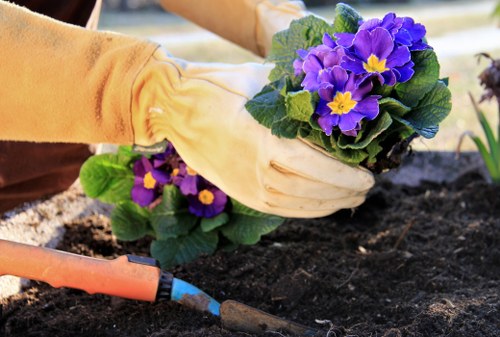Lawn Mowing in Crossness: Your Comprehensive Guide

Maintaining a beautiful lawn in Crossness requires dedication, the right tools, and expert knowledge. Whether you're a homeowner or managing a commercial property, regular lawn mowing is essential for the health and aesthetics of your greenery.
Crossness, located in the vibrant area of southeast London, offers a unique climate and soil conditions that influence how your lawn should be cared for. Understanding these local factors is key to achieving a lush, green lawn year-round.
In this guide, we will explore the best practices for lawn mowing in Crossness, discuss the tools you need, and highlight the services available to help you maintain your outdoor space effectively.

Understanding Lawn Mowing in Crossness
Lawn mowing is more than just cutting grass; it's about promoting healthy growth and ensuring your lawn remains an attractive feature of your property. In Crossness, factors such as climate, soil type, and grass species play a significant role in determining the best mowing practices.
Climate Considerations: Crossness experiences a temperate maritime climate with mild winters and warm summers. This climate supports a variety of grass types, each requiring specific mowing techniques to thrive.
Soil Type: The soil in Crossness can vary, but it's typically a mix of clay and loam. Proper soil management, including aeration and fertilization, complements regular mowing for optimal lawn health.

Essential Tools for Lawn Mowing
Having the right tools is crucial for effective lawn mowing. Here are the essential tools every Crossness homeowner should consider:
- Mower: Whether you prefer a push mower, electric mower, or a ride-on mower, choosing the right type depends on the size of your lawn and your personal preferences.
- Trimmer: A trimmer helps achieve precise edges and tackle areas that the mower can't reach.
- Leaf Blower: Removing grass clippings and leaves ensures your lawn stays clean and healthy.
- Protective Gear: Safety first! Wearing gloves, goggles, and sturdy footwear protects you during mowing.
Investing in high-quality tools not only makes the mowing process easier but also contributes to the overall health of your lawn.

Best Practices for Mowing Your Lawn
Adopting the right mowing practices can significantly enhance the appearance and health of your lawn. Here are some tips tailored for Crossness:
- Maintain the Right Height: Different grass types require different mowing heights. Generally, keeping your grass between 2.5 to 3.5 inches promotes deep root growth and resilience.
- Mowing Frequency: During the growing season, mow your lawn once a week. Adjust the frequency based on growth rate and weather conditions.
- Sharp Blades: Ensure your mower blades are sharp to make clean cuts, reducing stress on the grass and preventing disease.
- Alternate Mowing Patterns: Changing your mowing direction each time helps prevent soil compaction and promotes even growth.
- Remove Clippings: While leaving grass clippings can provide nutrients, excessive clippings can smother the lawn. Remove them regularly for optimal health.

Seasonal Lawn Care Tips
Different seasons require different lawn care strategies to keep your grass healthy and vibrant:
Spring
- Begin mowing as the grass starts to grow, gradually increasing the mowing height.
- Fertilize to provide essential nutrients for new growth.
- Aerate the soil to improve oxygen and water penetration.
Summer
- Mow regularly to maintain appropriate height, especially during hot periods.
- Water deeply and infrequently to encourage deep root growth.
- Control weeds to prevent competition for resources.
Autumn
- Continue regular mowing until growth slows.
- Fertilize one last time to prepare the lawn for winter.
- Rake fallen leaves to prevent mold and disease.
Winter
- Limit mowing as grass growth slows or stops.
- Protect the lawn from frost and heavy snow by ensuring proper drainage.
- Plan for spring lawn care activities.
Choosing the Right Lawn Mowing Service in Crossness
For those who prefer to leave lawn care to the professionals, selecting the right service in Crossness is essential. Consider the following factors when making your choice:
- Experience: Look for services with a proven track record in Crossness and surrounding areas.
- Range of Services: Ensure the company offers comprehensive services, including mowing, trimming, fertilizing, and aeration.
- Customer Reviews: Positive testimonials can indicate reliability and quality of service.
- Pricing: Compare quotes to find a service that fits your budget without compromising quality.
- Scheduling Flexibility: A service that accommodates your schedule ensures your lawn is maintained regularly.
By carefully evaluating these factors, you can choose a lawn mowing service that meets your needs and keeps your Crossness lawn looking its best.
Local Areas Near Crossness for Lawn Mowing Services
Crossness is surrounded by several areas that also benefit from expert lawn mowing services. Here are some nearby locations:
- Abbey Wood: Just a short distance away, Abbey Wood offers lush gardens that require regular maintenance.
- Belvedere: Known for its picturesque parks, Belvedere residents often seek professional lawn care.
- Bow Creek: With its scenic river views, Bow Creek lawns benefit from tailored mowing services.
- Erith: Erith's spacious lawns and gardens make it a prime area for dedicated lawn care.
- Plumstead: Plumstead homes feature diverse green spaces requiring specialized mowing techniques.
- West Hornchurch: West Hornchurch blends urban living with beautiful lawns that need regular upkeep.
- Thamesmead: The expansive public gardens in Thamesmead are maintained by skilled professionals.
- Woolwich Ferry: Woolwich Ferry's community lawns are a testament to effective lawn mowing practices.
- Grove Park: Grove Park's residential areas are dotted with well-maintained lawns.
- Greenhithe: Greenhithe's blend of residential and commercial properties benefits from comprehensive lawn services.
Each of these areas has its unique characteristics, making it essential to choose lawn mowing services that understand the specific needs of each locality.
Benefits of Regular Lawn Mowing
Regular lawn mowing offers numerous benefits that go beyond mere aesthetics:
- Promotes Healthy Growth: Cutting grass at the right height encourages robust root development and thicker blades.
- Prevents Weeds: Regular mowing helps keep weeds at bay by removing their potential to seed.
- Enhances Curb Appeal: A well-mowed lawn significantly boosts the overall appearance of your property.
- Reduces Pest Problems: Shorter grass can deter pests that thrive in overgrown lawns.
- Conserves Resources: Maintaining optimal grass height reduces the need for excessive watering and fertilization.
Eco-Friendly Lawn Mowing Practices
Adopting eco-friendly lawn mowing practices contributes to a healthier environment:
- Mow at Recommended Heights: Letting grass grow slightly longer provides shade to the soil, reducing evaporation and promoting biodiversity.
- Use Electric or Manual Mowers: These options produce fewer emissions compared to gas-powered mowers.
- Leave Grass Clippings: Grass clippings can act as natural fertilizer, returning nutrients to the soil.
- Limit Mowing Frequency: Only mow when necessary to avoid over-stressing the grass.
- Maintain Equipment: Regular maintenance of mowing equipment ensures efficient operation and reduces fuel consumption.
Common Lawn Mowing Challenges in Crossness
Residents in Crossness may encounter specific challenges when mowing their lawns:
- Weather Conditions: Unpredictable weather can affect grass growth patterns, making it essential to adjust mowing schedules accordingly.
- Pest Infestations: Pests like grubs and lawn beetles can damage grass, requiring proactive treatment.
- Soil Compaction: Heavy foot traffic can compact soil, hindering grass roots and water absorption.
- Equipment Maintenance: Regular upkeep of mowing equipment is necessary to ensure optimal performance.
- Grass Diseases: Fungal infections can spread quickly, necessitating prompt and effective treatment.
Addressing these challenges with informed strategies ensures your Crossness lawn remains healthy and vibrant throughout the year.
Tips for a Sustainable Lawn
Creating a sustainable lawn benefits both your property and the environment:
- Choose Native Grass Species: Native grasses are better adapted to local conditions and require less maintenance.
- Implement Rainwater Harvesting: Collecting rainwater for irrigation reduces water usage.
- Reduce Chemical Use: Opt for organic fertilizers and pest control methods to minimize environmental impact.
- Promote Biodiversity: Plant diverse grass types and flowers to attract beneficial insects and wildlife.
- Practice Proper Lawn Maintenance: Regular mowing, aeration, and fertilization maintain lawn health without excessive resource consumption.
Innovations in Lawn Mowing Technology
Advancements in technology have revolutionized lawn mowing, offering more efficient and eco-friendly solutions:
- Robotic Mowers: Automated mowers can maintain your lawn with minimal intervention, saving time and energy.
- Smart Mowers: These mowers are equipped with sensors and connectivity features, allowing for precise control and scheduling.
- Battery-Powered Mowers: Offering a cleaner alternative to gas-powered mowers, battery-powered models reduce emissions and noise levels.
- GPS-Guided Mowers: GPS technology ensures comprehensive coverage of your lawn, preventing missed spots and over-mowing.
- Solar-Powered Mowers: Harnessing solar energy provides a sustainable power source for your mowing needs.
Hiring a Professional Lawn Mowing Service
While DIY lawn mowing is an option, hiring a professional service in Crossness offers several advantages:
- Expertise: Professionals have the knowledge and experience to handle various lawn types and conditions.
- Time-Saving: Outsourcing lawn care frees up your time for other activities.
- Quality Results: Experienced lawn care providers ensure a consistently well-manicured lawn.
- Comprehensive Services: Many services offer additional care options like fertilization, aeration, and pest control.
- Equipment Provision: Professional services come equipped with the necessary tools and machinery.
Choosing a reputable lawn mowing service can enhance the beauty and health of your Crossness lawn with minimal effort on your part.
Cost Factors for Lawn Mowing in Crossness
The cost of lawn mowing services in Crossness can vary based on several factors:
- Lawn Size: Larger lawns require more time and resources, increasing the overall cost.
- Frequency of Service: Regular maintenance typically offers better rates compared to one-time services.
- Additional Services: Services like fertilization, aeration, and pest control add to the cost but provide added benefits.
- Equipment Quality: High-quality equipment can ensure efficient service but may come at a higher price.
- Seasonal Demand: Prices may fluctuate based on the time of year and demand for services.
Understanding these factors can help you budget effectively for your lawn mowing needs in Crossness.
Maintaining Your Lawn Year-Round
Consistent care throughout the year ensures your lawn remains healthy and attractive in all seasons:
- Spring Care: Focus on cleaning up winter debris, aerating the soil, and fertilizing to promote new growth.
- Summer Maintenance: Regular mowing, watering, and weed control are essential during the hot months.
- Autumn Preparation: Prepare your lawn for winter by reducing mowing frequency and applying a final round of fertilizer.
- Winter Protection: Minimize foot traffic on the lawn and protect it from frost and freezing temperatures.
By following a year-round maintenance plan, you can enjoy a lush lawn that enhances the beauty of your Crossness property consistently.
Choosing the Right Grass for Crossness Lawns
Selecting the appropriate grass type is fundamental to achieving a thriving lawn in Crossness:
- Ryegrass: Ideal for cooler climates, ryegrass offers a dense and durable lawn cover.
- Bermuda Grass: Suitable for warmer areas, Bermuda grass is resilient and requires less water.
- Fescue: Fescue is shade-tolerant and maintains its color well, making it versatile for various lawn conditions.
- Kentucky Bluegrass: Known for its rich color and fine texture, Kentucky Bluegrass provides an aesthetically pleasing lawn.
- St. Augustine Grass: Prefers warm climates and thrives in well-drained soils, perfect for areas with ample sunlight.
Consulting with local lawn care experts can help you choose the best grass type suited to Crossness's climate and soil conditions.
Environmental Impact of Lawn Mowing
Lawn mowing practices can have significant environmental impacts. Here are ways to minimize negative effects:
- Reduce Mowing Frequency: Allowing grass to grow slightly longer can improve carbon sequestration and reduce the need for fertilizers.
- Use Sustainable Equipment: Electric or manual mowers emit fewer pollutants compared to gas-powered alternatives.
- Implement Mulching: Mulch your clippings to naturally fertilize the lawn, reducing waste and the need for chemical fertilizers.
- Create Wildlife Habitats: Incorporate native plants and flowers to support local biodiversity.
- Practice Integrated Pest Management: Use natural pest control methods to minimize chemical usage.
Adopting these environmentally friendly practices contributes to a healthier ecosystem and a more sustainable lawn maintenance routine.
Conclusion: Achieving a Perfect Lawn in Crossness
Maintaining a pristine lawn in Crossness involves understanding the local climate, soil conditions, and adopting best practices for mowing and care. Whether you choose to manage your lawn yourself or hire professional services, the key is consistency and informed decision-making.
By following the guidelines outlined in this guide, you can ensure your Crossness lawn remains healthy, vibrant, and a source of pride for your property.
Frequently Asked Questions
1. How often should I mow my lawn in Crossness?
During the growing season, it's recommended to mow your lawn once a week. Adjust the frequency based on grass growth and weather conditions.
2. What is the best grass type for lawns in Crossness?
Grass types like Ryegrass, Fescue, and Kentucky Bluegrass are well-suited for Crossness's climate. Consult with local lawn care experts to choose the best option for your specific conditions.
3. Should I leave grass clippings on the lawn after mowing?
Yes, leaving grass clippings can act as a natural fertilizer, returning nutrients to the soil. However, ensure not to leave excessive clippings to prevent smothering the grass.
4. When is the best time to fertilize my lawn in Crossness?
The best times to fertilize are in the spring and autumn, providing essential nutrients during the peak growing seasons.
5. How can I make my lawn more eco-friendly?
Adopt practices like using electric or manual mowers, reducing mowing frequency, leaving grass clippings as mulch, and choosing native grass species to create an eco-friendly lawn.